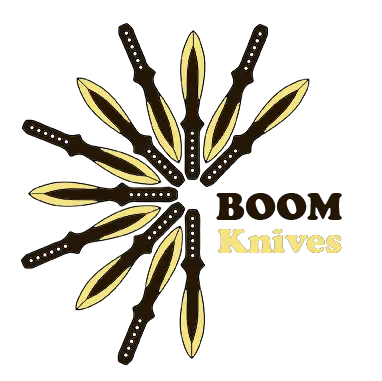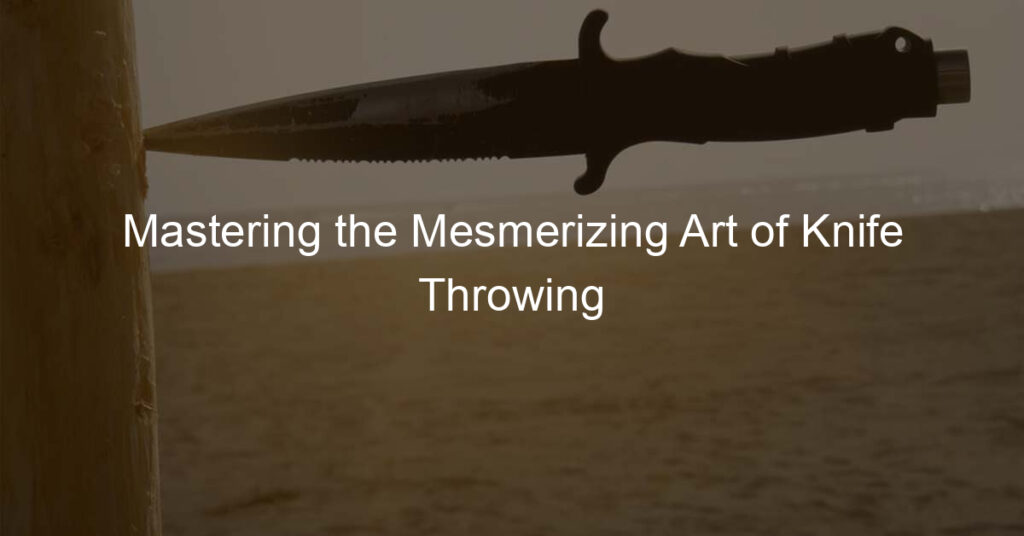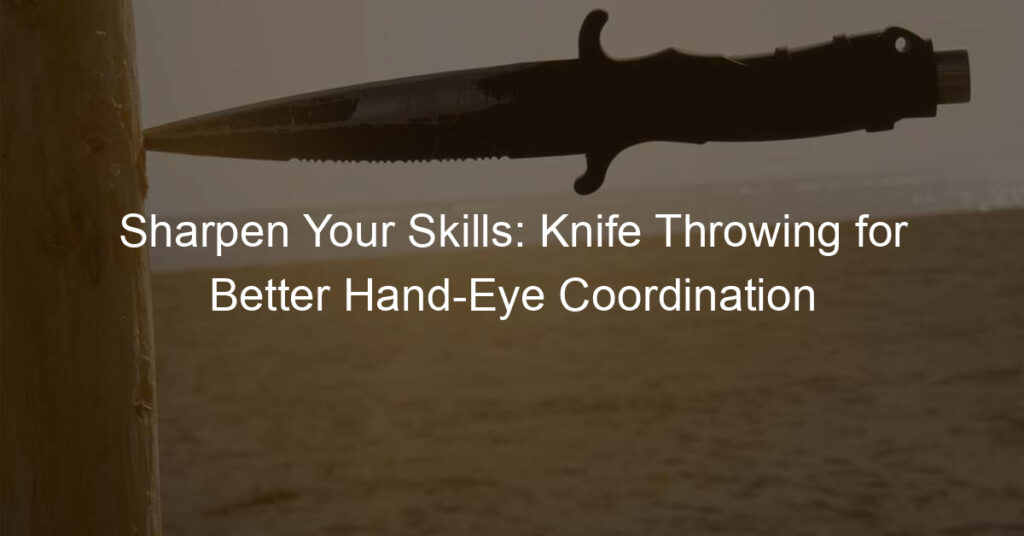Introduction to Knife Throwing
A fascinating activity that combines precision, focus, and skill. It is both a recreational sport and a performance art, captivating audiences worldwide. In this section, we will explore what knife throwing is and why it is considered an art.
-
- What is Knife Throwing?
It requires a keen eye, a steady hand, and a good understanding of physics. The thrower must calculate the distance to the target, the weight of the knife, and the rotation it will make in the air to land accurately. It’s a skill that can take years to master, but with practice, anyone can learn to throw a knife accurately and safely. Learn more about knife throwing on Wikipedia.
-
- Why is Knife Throwing considered an art?
It requires a high level of skill, precision, and creativity. Like any other art form, it’s not just about the technical aspects; it’s also about the expression. Each thrower has their own unique style and technique, making every performance unique. The beauty of knife throwing lies in the balance between danger and control, the thrill of the throw, and the satisfaction of hitting the target. It’s a dance of sorts, a ballet of blades, and that’s what makes it an art.
History of Knife Throwing
-
Origins of Knife Throwing
Back to prehistoric times when early humans used sharp tools for hunting and protection. As civilizations evolved, so did the use of knives. The art of throwing knives was developed and refined, becoming a skill used in warfare and hunting. Wikipedia provides a detailed account of the early history of knife throwing.
-
Evolution of Knife Throwing Techniques
Initially, knife throwing was a survival skill, but it has now become a sport and a form of entertainment. The techniques have been refined to improve accuracy and safety. Some of the popular techniques include the handle grip, blade grip, and no spin throw. Each technique requires a different level of skill and practice.
-
Knife Throwing in Popular Culture
Found its place in popular culture, featuring prominently in movies, television shows, and literature. It’s often depicted as an exciting and dangerous skill, adding an element of thrill to the narrative. Some famous examples include the James Bond films and the television series ‘Game of Thrones’. This widespread representation has contributed to the growing interest in knife throwing as a hobby and sport.
Professional Knife Throwing
Getting Started in Professional Knife Throwing
- Understanding the Basics
This includes knowing the different types of throwing knives, understanding the physics behind knife throwing, and learning the basic throwing techniques. You can start by reading books on knife throwing or watching instructional videos online. Wikipedia also has a comprehensive article on knife throwing that you can refer to.
- Finding a Mentor
Can provide you with valuable insights, tips, and feedback that you won’t get from books or videos. They can also help you avoid common mistakes that beginners make. You can find a mentor by joining a local knife throwing club or by reaching out to professional knife throwers online.
- Joining a Knife Throwing Club
A great way to meet like-minded individuals, learn from others, and practice your skills. Most clubs have regular meetups where members can practice together, share tips, and even compete against each other. You can find a local club by doing a quick online search or by asking your mentor for recommendations.
Advancing in Professional Knife Throwing
- Competing in Tournaments
Participating in knife throwing tournaments is a great way to test your skills against other professionals. These events can be local, national, or even international. They provide an opportunity to learn from others, gain experience, and potentially win prizes and recognition. The goal is not just to win but to improve your skills and learn from every throw.
- Developing a Unique Style
This could be a signature throw, a particular stance, or even a specific type of knife they prefer. Developing your own style makes you stand out and can make your throws more consistent and accurate. Experiment with different techniques and find what works best for you.
- Building a Reputation
This is achieved through consistent performance, sportsmanship, and contributing to the community. You can build your reputation by participating in forums, sharing your knowledge, and being respectful to other throwers. Your reputation is not just about your skills, but also about your character and contribution to the sport.
Knife Throwing Techniques
-
Basic Knife Throwing Techniques
- The Hammer Grip: This is the most common grip for beginners. The knife is held as if it were a hammer, with the thumb on one side of the handle and the rest of the fingers on the other.
- The Straight Throw: This involves throwing the knife straight ahead, with the blade pointing towards the target. It’s a simple yet effective technique.
-
Advanced Knife Throwing Techniques
- The Spin Throw: This involves throwing the knife in such a way that it spins in the air before hitting the target. It’s a challenging technique, but it can be very effective when done correctly.
- The No-Spin Throw: This is a difficult technique where the knife is thrown without spinning. It requires a lot of practice and precision, but it can be very accurate.
-
Secrets of the Masters
- Practice: The masters practice regularly to hone their skills. They understand that consistency is key to mastering any skill, including knife throwing.
- Precision: The masters focus on precision rather than power. They know that hitting the target accurately is more important than throwing the knife hard.
- Patience: The masters understand that learning to throw a knife accurately takes time. They are patient and persistent, and they don’t get discouraged when they miss the target.
Knife Throwing Safety
-
- Importance of Safety in Knife Throwing
Therefore, adhering to safety guidelines not only prevents accidents but also enhances your performance. A safe environment allows you to focus on your technique and accuracy, rather than worrying about potential hazards.
-
- Common Safety Mistakes to Avoid
These include throwing knives without a clear line of sight, using inappropriate knives for throwing, and not maintaining a safe distance from the target. It’s also important to ensure that the area behind your target is clear, as knives can bounce back if they don’t stick to the target.
-
- First Aid for Knife Throwing Injuries
Despite taking precautions, accidents can happen. Knowing basic first aid can be a lifesaver. For minor cuts, clean the wound with warm water and soap, apply an antibiotic ointment, and cover it with a clean bandage. For deeper wounds, apply pressure to stop bleeding and seek immediate medical attention. Safety should always be your top priority when engaging in knife throwing.
Knife Throwing Training
Physical Training for Knife Throwing
-
- Strength Training
It helps you maintain control over the knife and throw it with enough force to hit the target. Simple exercises like push-ups, pull-ups, and weight lifting can help build your upper body strength.
-
- Flexibility Training
It allows you to make the full range of motions required for different throwing techniques. Stretching exercises and yoga can help improve your flexibility.
-
- Endurance Training
Knife throwing can be a physically demanding activity, especially during competitions. Endurance training helps you stay energetic and focused, even after throwing knives for a long time. Cardio exercises like running, cycling, and swimming can boost your endurance.
Start with light exercises and gradually increase the intensity as your body gets used to the routine. Always warm up before training and cool down afterwards to prevent injuries.
Physical training for knife throwing is not just about building muscles. It’s about improving your overall physical fitness so you can perform better and enjoy the sport more.
Mental Training for Knife Throwing
-
- Focus and Concentration
It’s not just about throwing a knife at a target; it’s about being able to do so consistently and accurately. This requires the ability to block out distractions and focus solely on the task at hand. One way to improve your focus and concentration is through mindfulness exercises, such as meditation. These exercises can help you learn to clear your mind and focus on the present moment, which can be incredibly beneficial when you’re trying to hit a target with a knife.
-
- Overcoming Fear
Failure or injury can be a significant barrier to success. However, overcoming this fear is an essential part of mental training for knife throwing. One way to do this is by gradually increasing your comfort level with the sport. Start with smaller, less intimidating knives and work your way up to larger ones. Additionally, always ensure you’re practicing in a safe, controlled environment to help alleviate any fears of injury.
-
- Developing a Winning Mindset
This involves believing in your abilities, setting realistic but challenging goals, and maintaining a positive attitude, even when things don’t go as planned. Even the most skilled knife throwers didn’t become experts overnight. It takes time, patience, and a lot of practice. So, keep a positive attitude, stay focused on your goals, and don’t get discouraged if you don’t succeed at first.
Knife Throwing Equipment
-
- Choosing the Right Knife
The knife should be balanced, with the center of gravity in the middle. It should be made of a single piece of steel, without any moving parts. The length should be between 12 to 16 inches, and the weight should be between 200 to 300 grams. The knife should feel comfortable in your hand. Wikipedia has a comprehensive guide on choosing the right knife for throwing.
-
- Maintaining Your Equipment
Regularly check your knife for any damages or dullness. Sharpen your knife regularly, a throwing knife doesn’t need to be razor-sharp. It just needs to have a pointed tip. Clean your knife after every use to prevent rusting. Store your knife in a dry place to prevent moisture damage.
-
- Upgrading Your Gear
As you progress in your knife throwing journey, you might feel the need to upgrade your gear. Upgrading your gear doesn’t necessarily mean buying the most expensive equipment. It means buying equipment that suits your skill level. For example, as a beginner, a lighter knife might be easier to handle. But as you gain experience, a heavier knife can provide more stability and accuracy.
Knife Throwing Competitions
- Local and National Competitions
These events are usually organized by knife throwing clubs or associations, and they follow specific rules and regulations. For instance, the American Knife Throwers Alliance hosts several competitions throughout the year, attracting participants of all skill levels. These competitions not only test your accuracy and consistency but also provide an opportunity to learn from experienced throwers.
- International Competitions
These events, such as the World Knife Throwing League Championships, bring together the best knife throwers from around the globe. Competing at this level requires a high degree of skill, precision, and mental toughness. It’s not just about winning, but also about representing your country and promoting the sport of knife throwing.
- Preparing for a Competition
- Practice Regularly: Consistency is key in knife throwing. Make sure to practice regularly to improve your accuracy and timing.
- Know the Rules: Each competition has its own set of rules. Familiarize yourself with them to avoid any surprises on the day of the event.
- Mental Preparation: Knife throwing is as much a mental game as it is a physical one. Stay focused, visualize your throws, and keep a positive attitude.
Knife Throwing as Performance Art
-
Theatrical Knife Throwing
A dramatic art form that combines the precision and skill of knife throwing with the flair and spectacle of theatre. This form of performance often involves a thrower and an assistant, sometimes referred to as a “target girl”. The thrower hurls knives towards the assistant, who stands against a board, creating a thrilling spectacle. Theatrical knife throwing requires not only skill and precision but also a great deal of trust between the performers. It’s a breathtaking display of daring and skill that can leave audiences gasping in awe.
-
Knife Throwing in Circus Performances
The danger and precision involved in the act make it a crowd favorite. In a typical circus knife throwing act, the thrower aims at a rotating wheel where the assistant is strapped. The thrower must adjust their aim and timing to the rotation of the wheel, adding an extra layer of difficulty and excitement to the performance. According to Wikipedia, some of the most famous knife throwers, like The Great Throwdini, have performed in circuses, demonstrating the high level of skill required for this art form.
-
Creating a Knife Throwing Act
Requires a combination of technical skill, creativity, and showmanship. The thrower must first master the basics of knife throwing, including grip, stance, and throwing techniques. Once these skills are honed, the thrower can start to develop their unique act. This might involve incorporating elements of drama, comedy, or suspense, or developing a unique theme or narrative for the act. Safety is paramount in creating a knife throwing act, and performers must always ensure that their act is safe for themselves, their assistants, and their audience.
Conclusion: Mastering the Art of Knife Throwing
-
- Recap of Key Points
We’ve covered a lot of ground in this post, from the history of knife throwing to the techniques and safety measures that professionals use. We’ve learned that knife throwing is not just a sport, but also a form of performance art, with its own set of training methods and equipment. We’ve also discovered that there are competitions for those who wish to test their skills against others.
-
- Final Thoughts on the Journey to Mastery
Mastering the art of knife throwing is a journey that requires dedication, practice, and a respect for the craft. It’s not just about hitting the target, but also understanding the science behind each throw, the importance of safety, and the thrill of competition. As with any journey, the path to mastery is not always easy, but the rewards are well worth the effort.
Whether you’re a beginner looking to try something new, or a seasoned thrower seeking to refine your skills, we hope this guide has provided you with valuable insights into the art of knife throwing.







